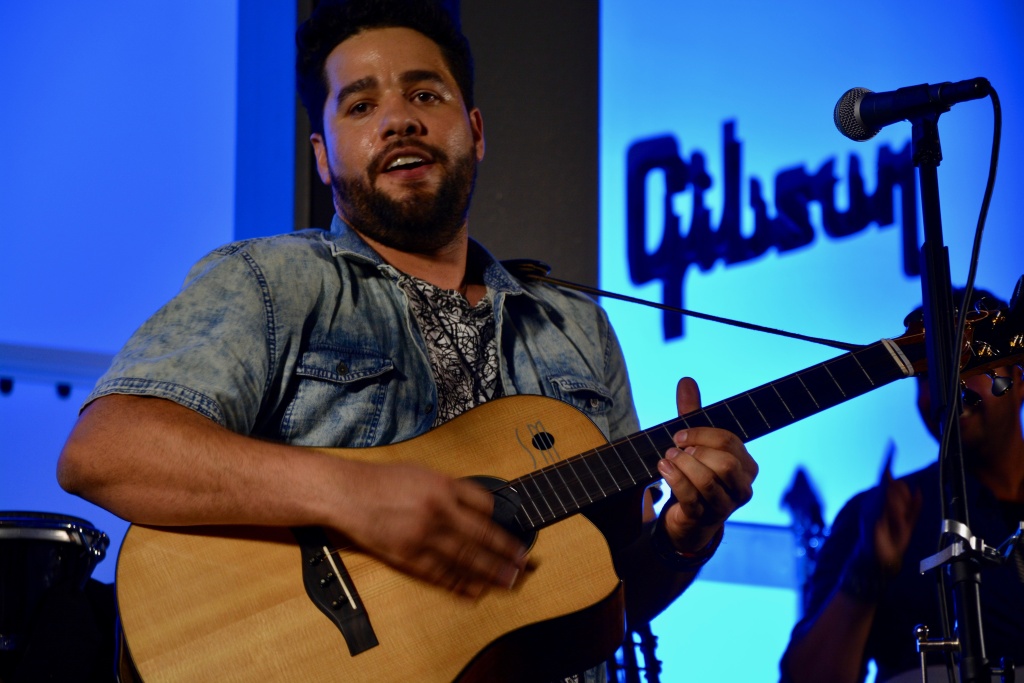A Cuban musician expands his sound in LA


A few years ago, a musician named San Miguel Perez came to the U.S. from Cuba, hoping to advance his career as a guitarist. He was a sideman in Havana, but he had dreams of recording a solo album of his own songs.
He always thought about making his first record with a traditional Cuban trio. Five years ago, that’s as far as his vision could go. But now, he says he surpassed those expectations, and he believes it’s all part of living in Los Angeles.
San Miguel (his stage name) hails from Río Cauto, a small town in the eastern Cuban province of Granma. He began playing music at age nine — first, classical guitar. Then at 14, he started playing another instrument called the tres — a guitar of three double-steel strings. At 18, San Miguel moved to Havana to attend Cuba’s top conservatory, Instituto Superior de Arte, to specialize in classical tres.
He learned to play all the classical styles, from baroque to romantic music. In addition to his 13 years of classical music training, San Miguel also carries the roots of his hometown, a style called nengón, the grandfather of the style known as son. “That’s the music of my land,” he says, “nengón, son and guaracha.”
After graduating from the conservatory, San Miguel began working in Havana as a sideman. He received a couple of music awards and played with played with several bands, including the renown orchestra Adalberto Alvarez y su Son. In 2010, San Miguel got a call from a friend who was coordinating the production of an album for a singer who needed someone who could play the tres.
L.A.-based singer Cecilia Noël was recording “Havana Rocks,” an album of ’80s pop hits arranged as Cuban dance tunes. She recalls: “They said, ‘We have the perfect guy for you, and he’s a young tresero.’ They called him and I met him at the session. And I remember the first time, it was like, Wow! — that sound carried me, this is exactly how I wanted my album to sound.”
Noël finished mixing the album in L.A.. When she returned to Havana she found out that San Miguel had moved to Florida. She called and asked him to join her band. “And he said, ‘Absolutely!’ I sent him the music and he learned every single note — everything, no papers, nothing. He came back and he played the show and everyone was, Qhhhhh, woooooow! And then, of course, Colin met him.”
Noël introduced San Miguel to Colin Hay, founder of the band, Men At Work. Hay says when San Miguel first came to his recording studio in Topanga, he brought a song called “Lluvia.” “He played the song perfectly. Very few people play the song and you don’t have to go back and do it again or you don’t have to fix anything, it’s just a rarity.”
Hay says it’s also unusual to find a musician who has all the skills, a novice songwriter whose songs have a structure: “Very rarely do you have somebody who’s just embarking in what I would call that ‘period of ascension,’ where you’re taking off, where mostly you do your best work, when you’re almost ready. ‘Cause when you’re ready, you’re a bit too sure of yourself. It’s like if you’re on a plane, the most exciting part is when you’re taking off. Once you’re there, you’re like, Oh well, here we are.”
San Miguel says, 10 years ago, when he was back in Cuba, he never imagined he’d record a song like “Un poquito de amor everyday” — mixing Spanish and English, and going for a pop sound in his music.
San Miguel says he’s a tres player first and a singer-songwriter second. As a tres player, he wants to make sure not to lose his Cuban roots and the instrument’s identity. He says: “If you don’t strengthen your roots and stay tight, you can easily get diluted.”
San Miguel wants to keep the natural quality of the instrument at a high level and respect the identity of Cuban music. If his debut album is any indication, that should not be difficult to accomplish.
